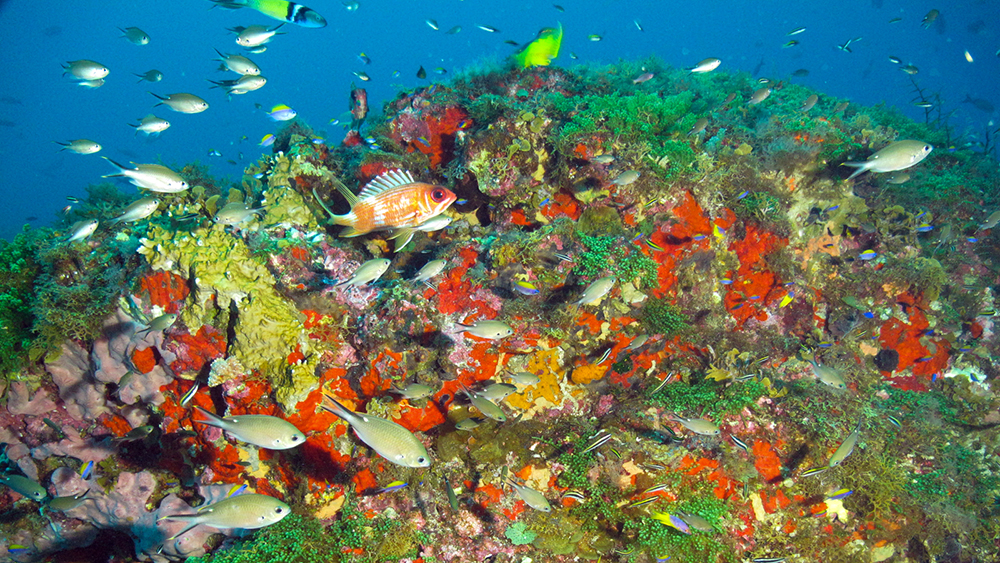We are investigating population connectivity for key coral, sponge, and fish species between shallow and mesophotic reefs of the Flower Garden Banks National Marine Sanctuary and its proposed expansion areas to the east. Marine protected areas (MPAs) were identified as a restoration approach for benthic habitats impacted by the Deepwater Horizon oil spill. Understanding how populations are connected will help managers develop MPAs that are effective and benefit present and future generations.

At a depth of 115 feet, Bright Bank features an algal/sponge community typical of many shallower bank areas. Credit: NOAA-FGBNMS/UNCW-UVP
Why We Care
The Gulf of Mexico is one of our nation’s most shared ocean spaces. Its outer continental shelf supplies over 22 percent of the total U.S. crude oil and natural gas production, and commercial fisheries landings average 1.4 billion pounds per year(from 2013 to 2015). The Gulf of Mexico’s coral reef ecosystems provide habitat, food, and shelter to hundreds of species of fishes and invertebrates, and play an economic role in supporting commercial fisheries and recreational industries. The anthropogenic and natural pressures placed on the Gulf of Mexico’s ecosystems can have lasting impacts on their condition, as evidenced by the annual hypoxic zone off the coast of Louisiana and the Deepwater Horizon oil spill. The establishment of MPAs to protect and conserve Gulf of Mexico ecosystems has been identified as one of the key restoration strategies for benthic communities affected by the Deepwater Horizon oil spill, and understanding how coral populations are connected to improve MPA design and management is the focus of our work.
What We Are Doing
We are studying the reefs and banks to the east of the Flower Garden Banks National Marine Sanctuary (specifically, the areas that are part of the proposed sanctuary expansion, Alternative 3) to determine their potential connectivity to the reefs of the sanctuary and other coral ecosystems further afield in the Gulf of Mexico and the Caribbean. Our objective is to provide information to improve management and protection of shallow reefs and mesophotic coral ecosystems, inform restoration, and help preserve long-term viability of these ecosystems. We seek to understand the processes that shape population connectivity for shallow and mesophotic coral ecosystems for eight species: two hard corals (Montastraea cavernosa and Stephanocoenia intersepta), two soft corals (Swiftia exserta and Hypnogorgia pendula), one black coral (Antipathes furcata), one sponge (Xestospongia muta), and two fishes (red snapper Lutjanas campechanus and vermillion snapper Rhomboplites aurorubens). To achieve these objectives, we will work to integrate field sampling and genetic, chemical, and ecological analyses with habitat suitability, oceanographic, and larval dispersal modeling. Additionally, we will be looking at coral recruitment and species biodiversity through the use of Autonomous Reef Monitoring Structures or ARMS.
To ensure that our project and its outputs are useful to managers, we will work closely with resource managers to translate our results. The results of this study will provide information on regional population connectivity and help Gulf of Mexico resource managers make informed decisions regarding current and future MPAs for shallow and mesophotic coral ecosystems.
This work is part of the Regional Ecosystem Prediction Program and funded by NCCOS and the Office of Ocean Exploration and Research in collaboration with the Office of National Marine Sanctuaries and the National Marine Fisheries Service's Southeast Regional Office. It is led by Santiago Herrera (Lehigh University), and represents a collaboration of 16 scientists at seven different universities, three federal laboratories (NOAA’s National Centers for Coastal Ocean Science and Southeast Fisheries Science Center, and the U.S. Geological Survey), and the Smithsonian Institution.
 Official websites use .gov
A .gov website belongs to an official government organization in the United States.
Official websites use .gov
A .gov website belongs to an official government organization in the United States. Secure .gov websites use HTTPS
A lock or https:// means you’ve safely connected to the .gov website. Share sensitive information only on official, secure websites.
Secure .gov websites use HTTPS
A lock or https:// means you’ve safely connected to the .gov website. Share sensitive information only on official, secure websites.